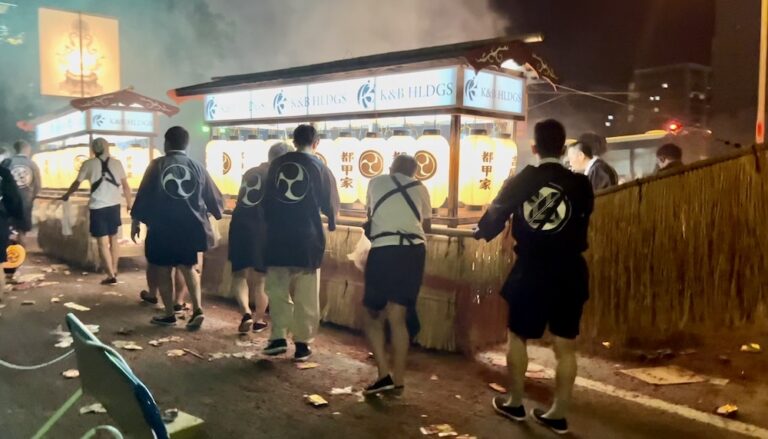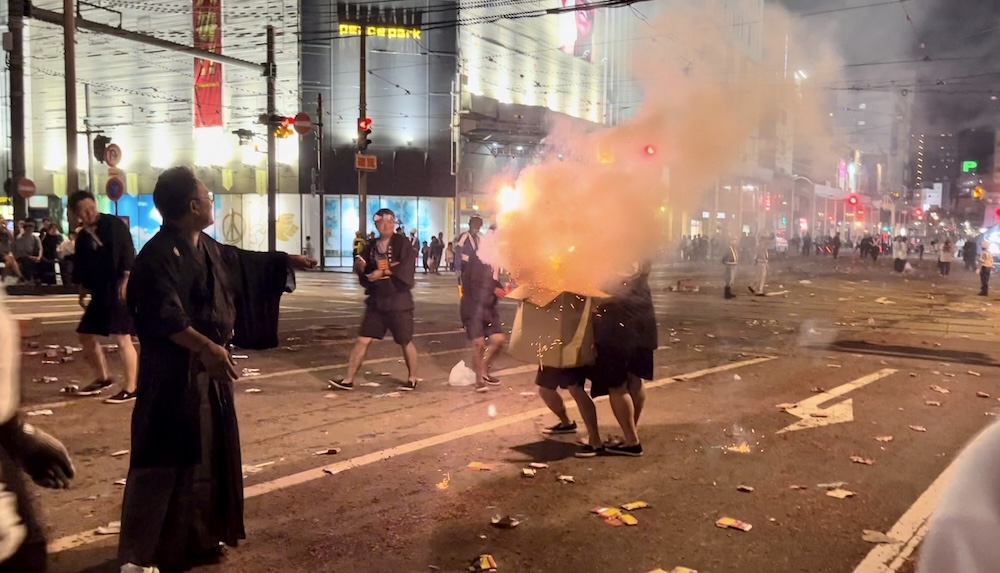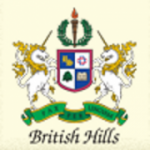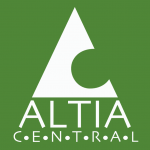
If you’ve researched national holidays in Japan at all, you’ve undoubtedly come across Obon (お盆). This is a festival held in August to remember deceased ancestors and close relatives. While most of Japan takes three days during the month to perform dances, sing, and visit their family’s tomb, Nagasaki, a city all the way at the bottom end of the country, puts on an event unlike anywhere else in the country called Shōrō Nagashi (精霊流し). The name literally means “setting adrift spirits of the ancestors”, and traditionally the event involved families parading commemorative lantern-lit floats for recently deceased family members around town, before setting them on fire and out into Nagasaki Bay.
Shōrō Nagashi’s History
Nagasaki is, of course, most well-known in the present-day for being one of only two cities in the world to have been devastated by an atomic bomb.
However, many people forget that Nagasaki has a long and frankly very interesting history as the only international trading port in Japan during the country’s centuries-long period of isolationism. Initially, trade was conducted with European countries like the Netherlands and Portugal, but eventually this extended to China. Shōrō Nagashi is said to have originated as a Chinese holiday introduced by the immigration and subsequent exchanges between these two cultures. The concentration of Chinese nationals in Nagasaki led to it being the only prefecture in Japan to adopt this event.
Although Shōrō Nagashi is a day of remembrance and should thus be approached with a respectful attitude, this is not the solemn funeral march some from the West might expect. Throughout the evening you’ll hear chimes, drums, and loud chanting. One of the most exciting parts of this festival is the use of firecrackers, or bakuchiku (爆竹)! It’s also undeniably the thing that gives the day’s atmosphere a more lighthearted and celebratory feel – a nice contrast to the somber and subdued approach adopted in places like the US.
What to Expect
Now that we’ve established that Shōrō Nagashi (精霊流し) is meant to commemorate a deceased loved one, you may be wondering exactly what that entails.
The most iconic part of this festival is undoubtedly the Shōrō-bune (精霊船), or “Spirit Boat” itself. It is said that the spirit of the deceased is guided to its final resting place in the nagashi-ba (流し場), or afterlife, via the boat built by the individual’s family. The variety of these spirit boats is impressive: they come in all sizes and styles! Just last year, I saw a boat adorned with adorable cut outs of black cats and an impressive blow up cat head mounted to the front of what appeared to be a grandmother’s ride into the next world.

The boats’ final destination is Nagasaki Bay, where they are symbolically destroyed by a crane after being paraded around town. Traditionally, the boats were lit on fire and sent out into the bay where they would eventually sink to the bottom, but for environmental reasons, this practice was discontinued many years ago.
When to See It
Shōrō Nagashi is held on August 15th every year. Unlike Obon, this event is a one-day celebration, so mark your calendar! There’s no official start time, as people have to wheel their group floats into town, but things start happening in the late afternoon. If you’re anywhere near town you’ll probably start hearing firecrackers and drums. The processions really start to heat up (no pun intended) around dusk.
Where to Look for It
While the tradition may have originally been Chinese, nowadays, hundreds of thousands of people congregate in the city center to celebrate this distinctly Nagasaki event together. The procession can be viewed all along the main road in the city, which extends from around Shiambashi to Ohato tram stop. In general, as long as you’ve found one of these two stations, you won’t need a map to tell you where to go – the enormous crowds and sounds of firecrackers will lead the way!
The nice thing about Nagasaki in general, but especially when it comes to festivals that move around the city like this one, is its size. Nagasaki is incredibly walkable, so you can get from point A to point B within 20 minutes on foot. You’ll find the trams and buses around the time of this event to be quite crowded, so if you’re staying close to the city center, walking is recommended.
Manners & Things to Note
While it’s easy to get caught up in the festivities of the day, it’s important to remember that this is an event to commemorate the dead. Many people are taking this day to celebrate and remember family members like parents, grandparents, children, and even pets. With this in mind, there are some seemingly obvious, but easy-to-forget rules to keep in mind.
Personally, and according to the Japanese coworkers I’ve asked, I think having a drink or two while watching the procession is perfectly acceptable. Shōrō Nagashi occurs in the dead of summer (usually) on a weekday, so the weather is hot, and it’s a nice excuse to crack open a Kirin and relax a little. Of course, this isn’t an excuse to get drunk and cause any trouble or draw attention away from the celebration. When in doubt, it’s always best to do as the locals around you do.
Firecrackers are another aspect that are easily misunderstood. Kids and adults alike love them, and they’re probably one of the most exciting parts of this event. However, you should leave it to the participants and refrain from bringing your own. If one of the participants hands you a firecracker it’s of course fine to throw it yourself, but make sure you look before you throw – you don’t want to hit anyone!

The one thing you definitely DON’T want to forget
On that note, one of the most important things that you DO NOT want to forget if you make it to the festival is earplugs. You’ll notice most people at the festival wear them, and small children are even fitted with noise-canceling earmuffs. If you did forget some, you can stop by a 100 yen shop and buy a pair of cheap earplugs. If you need help finding some, ask for mimi-sen (耳栓). Honestly, if I forget my earplugs, I will either buy more or go all the way home to get mine. Yes – it gets that loud.
Nagasaki often gets overlooked as a travel destination both among foreign travelers, and the Japanese themselves. Its size and location are the biggest contributors to this, especially since it is often overshadowed by Hiroshima’s similar recent history. However, if you have a chance to visit during the Obon period, you should absolutely take it to see this festival – it really is unique to any other I’ve ever been to in Japan!















